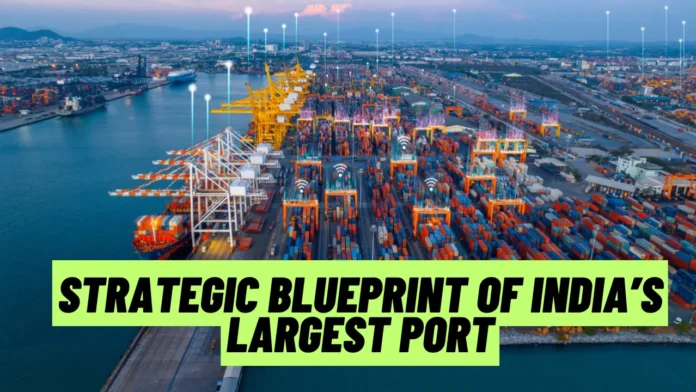India’s largest port, the Jawaharlal Nehru Port Trust (JNPT), also known as Nhava Sheva, is a critical gateway for India’s international trade. Located near Mumbai, JNPT handles around 55-60% of India’s containerized cargo, making it the largest container port in the country. The strategy behind the port’s success and continuous growth can be understood through several key dimensions:
1. Strategic Location:
- Proximity to Major Trade Routes: JNPT is strategically located near the Arabian Sea, providing easy access to major global shipping routes. This location makes it an ideal point for both import and export activities, especially with markets in Europe, Africa, the Middle East, and Southeast Asia.
- Close to Industrial Hubs: The port’s proximity to Mumbai, Pune, and Gujarat—key industrial and manufacturing hubs—ensures a steady flow of goods. This reduces logistics costs and transit time for businesses operating in these regions.
2. Infrastructure Development:
- Modern Container Terminals: JNPT has invested heavily in modernizing its container terminals, equipped with state-of-the-art handling equipment. This has increased the port’s capacity and efficiency in handling large volumes of cargo.
- Dedicated Freight Corridors: The port is well-connected to the Western Dedicated Freight Corridor (DFC), which enhances rail connectivity to the hinterland, reducing congestion on roads and ensuring faster movement of goods.
- Expansion Projects: To meet the growing demand, JNPT has been continuously expanding its capacity. The development of the 4th terminal and additional berths are examples of this strategy.
3. Operational Efficiency:
- Digitization and Automation: JNPT has implemented several digital initiatives, such as Direct Port Delivery (DPD) and Port Community System (PCS), to streamline operations. These initiatives reduce paperwork, speed up cargo clearance, and enhance overall efficiency.
- Public-Private Partnerships (PPP): The port has collaborated with private players to manage and operate terminals, which brings in expertise, investment, and modern technology. These partnerships have improved service quality and operational efficiency.
4. Policy Support:
- Government Initiatives: The Indian government’s focus on boosting port infrastructure through initiatives like Sagarmala has supported JNPT’s growth. Policies aimed at simplifying trade processes, reducing turnaround times, and enhancing ease of doing business have been crucial.
- SEZ and Logistics Parks: The development of Special Economic Zones (SEZs) and logistics parks around the port has attracted industries and businesses, further driving traffic to the port.
5. Sustainability Focus:
- Green Initiatives: JNPT has adopted various green initiatives, such as shore power supply to reduce emissions from vessels, solar power generation, and wastewater recycling. This focus on sustainability is not only environmentally responsible but also attracts global shippers who prioritize eco-friendly practices.
6. Global Integration and Connectivity:
- International Alliances: JNPT has established strategic alliances with global shipping lines and logistics companies. This enhances its global connectivity and ensures that it remains a preferred port for international trade.
- Multimodal Connectivity: The port offers excellent multimodal connectivity—road, rail, and sea—which allows seamless movement of cargo across the country and beyond. This integration is crucial for reducing transit times and costs.
7. Customer-Centric Approach:
- Ease of Doing Business: JNPT has prioritized reducing transaction costs and turnaround times for its customers. Initiatives like online cargo tracking and faster customs clearance processes ensure that the port remains competitive and user-friendly.
- 24/7 Operations: The port operates round the clock, ensuring that there are no delays in cargo handling. This is particularly important for time-sensitive goods and enhances the port’s reliability.
8. Future-Ready Focus:
- Technology Adoption: JNPT is exploring the adoption of newer technologies like blockchain for secure and transparent transactions, AI for predictive analytics in cargo handling, and IoT for real-time tracking of goods.
- Capacity Expansion: With India’s trade expected to grow significantly, JNPT is preparing for the future with plans for further capacity expansion and infrastructure upgrades to handle larger vessels and more cargo.
Challenges and Competitor Strategies:
- Competition from Other Ports: Ports like Mundra (owned by Adani Ports) are fast catching up in terms of capacity and efficiency, challenging JNPT’s dominance. To counter this, JNPT needs to continuously upgrade its infrastructure and services.
- Congestion and Hinterland Connectivity: Despite improvements, congestion at the port and connectivity to the hinterland remain challenges. Continued investment in improving logistics networks and reducing bottlenecks will be crucial.

